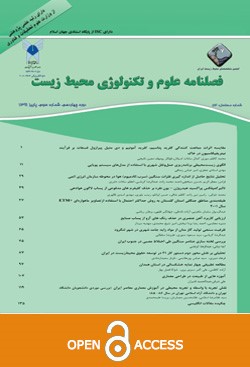واکاوی جایگاه روشنایی در کاهش جرایم شهری با تاکید بر رویکرد CPTED محدوده مورد مطالعه : کیانپارس – اهواز
محورهای موضوعی : محیط زیست شهری
پرویز سلیمانی مقدم
1
*
![]() ,
ستاره دینیاری
2
,
ستاره دینیاری
2
1 - استادیار، گروه جغرافیا، دانشگاه پیام نور، ایران. *(مسوول مکاتبات)
2 - کارشناس ارشد مدیریت شهری، مدرس دانشگاه پیام نور، ایران.
کلید واژه: جرم, روشنایی, پیشگیری, نورپردازی, رویکردCPTED, امنیت, طراحی,
چکیده مقاله :
زمینه و هدف: فضاهای شهری، محیط زندگی انسان و فعالیت های او به شمار می رود و جرایم به عنوان عامل مخرب اجتماعی از سوی انسان در این فضاها صورت می گیرد. از جمله معضلات مهم در فضاهای شهری که کیفیت زندگی و احساس امنیت شهروندان را تحت تأثیر قرار می دهد وقوع جرائم شهری است، که فاکتورهای مدیریت و برنامه ریزی شهری، فضاهای آشفته شهری و عوامل اجتماعی اقتصادی نقش مؤثری در وقوع یا بازدارندگی آن ایفا می کنند. این مقاله با روش میدانی به بررسی نقش روشنایی در کاهش جرایم شهری و ارتباط میان تعداد جرم و میزان روشنایی محیط در محله کیانپارس در شهر اهواز پرداخته است.روش بررسی: مقاله حاضر با روش توصیفیتحلیلی انجام گرفته است. در بخش توصیفی از آمار و اطلاعات مستخرج از سالنامه آماری 1397، اداره کل دادگستری استان خوزستان و کلانتری محله و داده های میدانی استفاده شده و در نهایت تجزیه و تحلیل داده ها توسط نرم افزارهای GIS و نسخه 19 SPSS انجام شده است.یافته ها: بررسی ها نشان می دهد مجرمان در انتخاب زمان و مکان بزهکاری کاملا منطقی عمل می کنند و مناسب ترین و کم خطرترین مکان ها و مناطقی که از نظر نور پردازی ضعیف هستند را برای اعمال مجرمانه برمی گزینند و رابطه معکوسی بین وقوع جرم و روشنایی وجود دارد.بحث و نتیجه گیری: نتایج کلی حاکی از آن است که از مجموع 275 جرم واقع در فضاهای عمومی و خصوصی، تعداد 200 مورد در گستره نوری شماره یک با کمترین میزان روشنایی و تعداد 19 مورد در گستره نوری شماره 4 با بیشترین میزان روشنایی روی داده است و همچنین بررسی ها نشان میدهد که وضعیت ضعیف نورپردازی در کیانپارس منجر به کاهش امنیت و بروز جرائمی از قبیل سرقت شده است و به طور کلی سامانه نورپردازی محل مورد مطالعه، ناکارا و مغایر با اصول CPTED ارزیابی شد.
Background and Objective: Urban spaces are the environment of human life and its activities. Crimes are committed as a destructive social phenomenon by man in these spaces. Among the major problems in urban spaces that affect the quality of life and the sense of security of citizens is the occurrence of urban crime, and factors such as urban planning, design, sprawl and social –economics, play an effective role in its occurrence or deterrence. Kianpars neighborhood can always face dangers like urban crime, depending on its location.Method: This article is a descriptive-analytic one. In the descriptive section, statistics and information extracted from the Statistical Yearbook, the supreme court of the Khuzestan and police department of the study area were used. Finally, for analyzing the data, GIS and SPSS softwares have been used to analyze the relationship between the two factors of crime incidence and brightness levels Within the Kianpars area.Findings: Investigations show that criminals act reasonably well in choosing the time and place of the crime and select the most appropriate and least risky locations and areas that are poorly lit for criminal activity and there is an inverse relationship between crime and light.Discussion and Conclusion: Overall results show that out of 275 crimes in public and private spaces, 200 cases occurred in the optical range No.1 with the least amount of light and 19 cases occurred in the optical range No.4 with the highest brightness, indicating a significant and inverse relationship between the amount of light and the crime number, as well as studies show that poor lighting in Kianpars has led to a decrease in security and incidence of some urban crime, and overall the lighting system in the study area has been assessed as inefficient and inconsistent with the CPTED principles.
_||_

